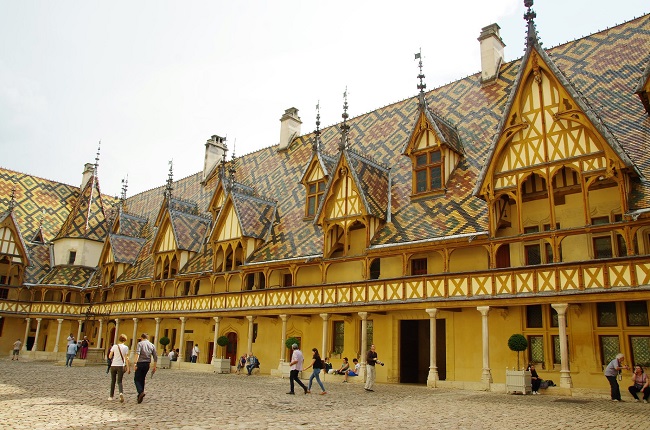Carnet de Voyage: More Than Just Mustard

Travel notes from the real France. Carnet de Voyage is a weekly personal travel story in France sent in by readers. If you’d like to write a story for Carnet de Voyage, head here for details on how to submit.
Burgundy is not often at the top of people’s lists when visiting France. After Paris, the most popular places are Provence, the Dordogne, the Côte d’Azur, the Loire Valley, Brittany and Bordeaux.
It may surprise you to learn that Burgundy actually boasts more châteaux than the Loire and more vineyards than Bordeaux. The region also has serene Benedictine and Cistercian monasteries, picturesque medieval walled cities, and the scenic Canal de Bourgogne. The countryside is gentle rather than dramatic, with rolling hills, and fields of yellow maize and sunflowers. The route des vins (wine route), meanders through terraced vineyards that transform the landscape into a sea of gold in autumn. The shady trails of the Morvan Regional Park, lead you through leafy forests of Alder, Ash, Willow, Elm, Sycamore and Maple, where you can escape the hot Burgundy sun. But if it is sun that you seek, then the beaches of the great Morvan lakes will provide you with that. The larger ones, such as Lac des Settons also offer a variety of water sports and have lakeside cafés and restaurants. My personal favourite, Lac Chamboux, doesn’t have any facilities, but exudes peace and tranquillity, and its untamed beauty has been likened to a Canadian lake in miniature.
For history buffs, the region has Roman sites at the bustling market town of Autun. And the Musée de la Résistance en Morvan, at Saint-Brisson, tells the story of Resistance activity in the area during WWII.
If visitors do come to the region, they usually head for the capital, Dijon, famed for mustard and the majestic Palais des Ducs – the former seat of the dukes of Burgundy, when Burgundy rivalled France for supremacy. Or Beaune to see the world-famous Hospices de Beaune, the 15th century free hospital built to treat the poor, with its fabulous multi-coloured polychrome tiled roof, that is synonymous of the region.

Beaune’s Hôtel Dieu © Lindy Viandier
Today however, I would like to introduce you to the small, but delightful town of Saulieu. Formally a Roman walled city, named Sedelocus (Inhabitants of Saulieu are still known as Sédélociens), Saulieu is the capital of, and gateway to, the Parc Naturel Régional du Morvan. On approaching the town, the first thing you see, rising above the rooftops, is the distinctive dome of the Basilica of Saint-Andoche that was built in the early 12th century on the site of a 6th century abbey church, (becoming a minor basilica in 1919).
The basilica is not the only building of note. No visit to Saulieu would be complete without taking a coffee, cognac or chilled Chablis at the ‘Café Parisien’, which dates back to the 19th century, and is a listed historic European café. Café Parisien serves delicious regional fayre; but if it is fine dining that you are after, Saulieu also has a two-star Michelin restaurant – ‘Bernard Loiseau’ named after the restaurant’s former celebrity chef. Past patrons include Orson Welles, Ernest Hemingway, Salvador Dali and Picasso.
The town retains an arty air, and boasts a faithful replica of Le Taureau, an impressive bronze bull sculpted by Saulieu’s most famous son, Francois Pompon. Every summer quirky, modern sculptures spring up in the medieval streets. This year, the giant head of a panther guards the entrance to the market.

Saulieu’s Café Parisien © Lindy Viandier
The vibrant Saturday market, is more than somewhere to come to buy your seasonal fruit and veg or local produce. It is a meeting place, where people gather to chat and exchange gossip, take a coffee, or even a glass or two of wine at the pop-up wine bar. The air is filled with the mingling aromas of tempting, fresh-baked bread, pungent cheeses and roasting farmer’s chickens.
There’s a rustic ambiance, with stalls selling artisan crafts such as hand-woven wicker baskets, ethnic wooden jewellery, and exotic carpets at equally exotic prices. And, to my delight, a second-hand book stall, that I can’t resist. Neither can I resist the colourful stalls selling traditional Moroccan tagines, and hand-painted ceramic knobs for cupboards and doors. I have to confess that I now have two tins full of them waiting for cupboards to be built to put them on…
A friend visiting Les Libellules, our 300-year-old house that we are renovating said, ‘You must have really researched this area before buying the house.’ The truth is, I saw a fairy-tale cottage with a round tower and fell under its spell – and also fell very lucky to have found a house here.
So, if you’re looking for somewhere different to visit, Burgundy truly does ‘cut the mustard’.
Read our other Carnet de Voyage entries here
You can read all about Lindy’s ‘Life at Les Libellules’ in her books ‘Damson Skies and Dragonflies’ and ‘Mellow Mists and Walnut Wine’ each charting a year in the Burgundy countryside and containing 18 seasonal recipes. Follow her “belle vie in Burgundy” on Instagram!
Lead photo credit : Mustard pots at the Saulieu market © Lindy Viandier
Share to: Facebook Twitter LinkedIn Email
More in Burgundy, Carnet de Voyage, life in France, Saulieu, stories
Leave a reply
Your email address will not be published. Required fields are marked *



